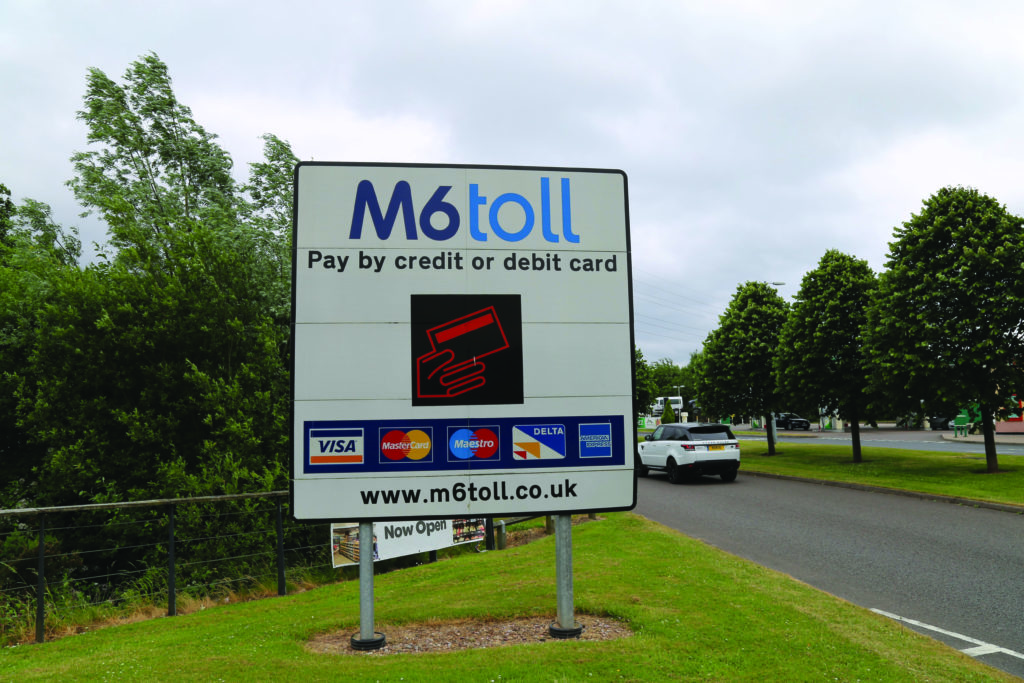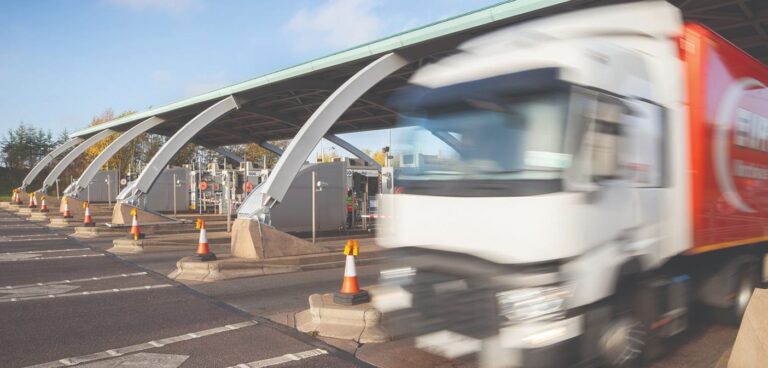
John Thornton speaks to Andy Cliffe, CEO of M6toll, about the multimillion-pound digital transformation of the free-flowing route’s existing tolling infrastructure…
Talk us through the existing tolling system infrastructure and when you first started to think about upgrading it…
The system currently in place is the same one that was there when the M6toll opened in 2003. It’s a combination of standard card payments and dedicated short-range communications-based tags.
Since 2018, we’ve done a lot of work to try to understand where the toll road performs well. It does a very good job at providing for long-distance journeys, which was what it was built to do. But we know there are opportunities to grow and to attract more traffic from either local journeys or inter-regional travel, whether it be cars or trucks. And the current system hampers our ability to do that.
So, in 2019, we started to look at alternative ways of providing a mass market opportunity or ability to use the toll road on a more mass-market basis. That’s when we also started to think about how we would charge for it, because the charging now is geared to support the long-distance role.
How does the new tolling system infrastructure differ to the existing one?
ANPR cameras will identify license plate data, removing the need for physical payment at the toll plazas and replacing them with a remote payment system. The technology is designed to enable seamless end-to-end journeys and means customers can manage all transactions via the M6toll website, whether for a single vehicle or a large fleet spread across a number of depots. However, we’re upgrading not only the tolling technology on the road itself, but also the customer service systems we use behind the scenes, including a new customer relationship management (CRM) system and e-commerce systems. We’re committed to providing hassle-free journeys and outstanding customer service and continuing to invest in the most innovative technology available is central to delivering on that promise.
Is this the biggest upgrade to M6toll since it opened in 2003?
Yes, I would agree with that. We won’t, or don’t intend to, completely replace card payment with ANPR. It’ll be another string to the bow. ANPR technology will ultimately allow us to charge closer to a per kilometre basis or on a junction-by-junction basis, rather than what effectively is a full charge today, regardless of how much of the road is used. The new system gives us much more flexibility and, through that, means that we can start to think about how we attract more regional journeys. That gives us an option to think about how we can take congestion off adjacent road networks, such as the A5 or A38, where there are some issues. We don’t want to step away from providing a great service to long distance journeys, but there’s definitely a balance to strike to make sure that we can help some of those other adjacent roads.
What is the ‘Road Ahead’ digital transformation programme and how does the new toll system form part of that initiative?
The Road Ahead investment strategy has been developed to support M6toll’s commitment to improving congestion and connectivity, nationally and across the West Midlands. The new technology will enhance a suite of ‘Savers’ products introduced in 2018, including the Hopper, Shuttle and FlexiPass options. The ‘Savers’ products have successfully attracted new trips by offering a range of options for those regularly using the road and helping to reduce congestion on alternative routes. Our new CRM and e-commerce systems will allow us to have an online presence that’s much more consumer facing and lead people to purchase those products online or buy them in a way that suits their travel patterns. It’ll help us start to turn the toll road from a strip of tarmac to a much more consumer facing business.
Has the pandemic affected the upgrade?
We didn’t pause during 2020, but it slowed us down a little bit, and we continue to develop our thinking through this. Inevitably, we needed to work through 2020 and the effects of Covid-19. Having done that, we’re now in a position to start our roll out this year.
Maritime was the first company to commence live trials of the new ANPR system in April. How many cameras have deployed in the first wave?
We’ve deployed 14 ANPR cameras so far, but we haven’t quite decided how many we’ll roll out in the final scheme. It really depends on the ultimate design that we choose to go for. I think we will settle on an answer to that question, probably over the next two or three months, but the intention is to cover the whole road.
How are you getting organisations involved in the live trials?
We spend a lot of time talking with logistics operators about the benefits of using M6toll opposed to the adjacent networks. We explain that we can offer both time and fuel efficiency savings that help providers run their operations more efficiently. Fleet operators want an easy solution that allows them to use the road efficiently. It’s not about whether they’ve got the right tag in the right vehicles. An ANPR system helps to attract operators to expand what they already do with us or to bring in new operators. We spend a lot of time, not just with the big 3PLs, but right across the whole network of potential operators.

Why are commercial vehicles the first to trial the new system?
Partly because there’s an easier fleet opportunity, and partly because the heavy vehicle market represents a big growth opportunity for us. Heavy vehicles have grown very strongly on the toll road, certainly over the last four or five years, and we wanted to continue to support that. These vehicles also represent one of the biggest ways to decongest adjacent parts of the network around us. From this summer we will start to look at the potentially higher volume, car-type journeys as well, but the trial as it is now allows it to be a little bit more stage managed and make sure the new system works as we expect it to. That programme will continue over the course of the next year or so as we move toward a full rollout.
Why did you choose Stantec to carry out the upgrade project?
Following a rigorous selection process involving sector-leading companies from around the globe, we commissioned Stantec to carry out the project. As a world-leading consultancy, Stantec is responsible for supporting the delivery of some of the best constructed and most technically efficient tolling systems available and we want it to deliver a similar standout project for the M6toll. Stantec’s team includes engineers, tolling, and technology specialists from the UK and the USA, which helps bring an international perspective into the UK. As you know, there isn’t a vast number of tolling operations in this country, and there are clearly many more in North America and Australia. So, what we were reaching for was to get that international flavour.
Some 50,000 motorists currently use the M6toll each day. Will the new toll system allow for an increase in vehicles that use the toll road?
That’s a pre-pandemic number. Over the course of 2020, we saw a drop of about 45% on 2019 levels, which had a pretty profound impact. We’re not at 2019 levels yet but we can see it recovering pretty swiftly. But, to answer your question, yes, absolutely. Not necessarily in terms of additional journeys, but potentially in terms of taking journeys off the congested parts of the network and moving more vehicles around.
Did the pandemic inform your decision to hold prices unchanged for vans and trucks using the toll road last year?
There were a few things at play, really. The Brexit situation was a little uncertain in terms of the impact on trucks, so we held prices last year and that hasn’t changed this year. Things inevitably will change, but its difficult to be clear about exactly when that will be. W hen some of that uncertainty settles down, we’ll start to think a little bit differently about it. Certainly, the rate of growth on the M6toll relative to the rest of the network has been much stronger and that’s something we continue to pursue.
Are you surprised that M6toll is still the UK’s only privately funded and maintained motorway?
It’s a good question. We regard M6toll as a huge success. It absolutely does what it was built to do and Highways England concurred when it did the post opening study. It is interesting that there aren’t more, and we’ll see how it pans out over the coming years.
Is tolling a dirty word in the UK?
In other walks of life, we’re very much used to paying for the usage of facilities and for assets. But there are certainly some strategic challenges around the subject of tolling. For example, how do you solve a declining fuel tax? How do you deal with congestion and growth in the economy while decarbonising the transport network and contributing to UK greenhouse gas targets? There’s a very interesting debate, I think, that will emerge over time.
What’s next for M6toll?
The Road Ahead programme is our real focus at the moment. It’s a true digital transformation of the business that will hopefully lead us being seen as a leading toll road operator globally. We’ll see where that takes us, but, for the moment, we’ve got huge ambitions for what we do with the business and grow to play a bigger part in the UK transport network.
This article originally appeared in the May 2021 issue of CiTTi Magazine





